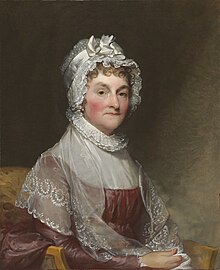Abigail Adams | |
|---|---|
 Portrait c. 1800–1815 by Gilbert Stuart | |
| First Lady of the United States | |
| In role March 4, 1797 – March 4, 1801 | |
| President | John Adams |
| Preceded by | Martha Washington |
| Succeeded by | Martha Randolph (acting) |
| Second Lady of the United States | |
| In role April 21, 1789 – March 4, 1797 | |
| Vice President | John Adams |
| Preceded by | Position established |
| Succeeded by | Ann Gerry |
| Personal details | |
| Born | Abigail Smith November 22, 1744 Weymouth, Massachusetts Bay, British America |
| Died | October 28, 1818 (aged 73) Quincy, Massachusetts, U.S. |
| Resting place | United First Parish Church Quincy, Massachusetts |
| Spouse | |
| Children | |
| Parent(s) | William Smith (father) Elizabeth Quincy (mother) |
| Relatives | Adams political family Quincy political family |
| Signature | |
Abigail Adams (née Smith; November 22, [O.S. November 11] 1744 – October 28, 1818) was the wife and closest advisor of John Adams, the second president of the United States, and the mother of John Quincy Adams, the sixth president of the United States. She was a founder of the United States, and was both the first second lady and second first lady of the United States, although such titles were not used at the time. She and Barbara Bush are the only two women in American history who were both married to a U.S. president and the mother of a U.S. president.[1]
Adams's life is one of the most documented of the first ladies; many of the letters she wrote to her husband John Adams while he was in Philadelphia as a delegate in the Continental Congress prior and during the American Revolution document the closeness and versatility of their relationship. John Adams frequently sought the advice of Abigail on many matters, and their letters are filled with intellectual discussions on government and politics. Her letters also serve as eyewitness accounts of the American Revolutionary War home front.
Surveys of historians conducted periodically by the Siena College Research Institute since 1982 have consistently found Adams to rank as one of the three most highly regarded first ladies by historians.
- ^ "Barbara Bush, matriarch of Bush dynasty, dies at 92". David Cohen. Politico. April 17, 2018. Retrieved November 27, 2019.